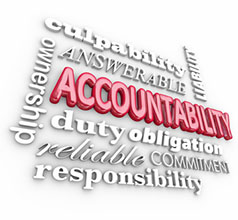Ability is Key for Employee Success
Employees make mistakes. It’s part of being human, but problem behaviours like lateness, dodging responsibility and not making work a priority while at work aren’t just mistakes. These are performance issues that need to be corrected immediately. Allowing certain problems to continue only sends the message of a lax environment and perpetuates the escalation of undesirable behaviours and the creation of additional new ones.
Do any of these situations sound familiar?
- A couple of employees work to only about 80% of their roles’ requirements – they get things done but certainly not efficiently or completely
- Certain individuals respond to problems by throwing others under the bus – they blame colleagues and others involved in the task or workflow
- Some people arrive late, take extended breaks and leave early while doing “just enough” work in between
- One or two employees are in their own little world and do their work without regard for others or timelines – they seem oblivious to how their role and their “silo” behaviour impacts others or work flow
Situations like these are common in many companies, regardless of business sector or industry. Managers and supervisors might be guilty of the problems or they might be the people challenged with addressing these issues. Either way, frustration runs high when problems are not resolved and the same, as well as new ones, keep popping up.
Because these problems are people based, these challenges are not isolated to one team or department. They can run through many levels, sections and even seasons. Rather than correcting the problems upon identifying them, supervisors and managers may foolishly (or hopefully) wait until costs to the business are incurred or conflict arises. When problems have been permitted to grow rampantly, others within the company are forced to seek a fix with an outside consultant for a trainer-led conflict resolution workshop or a team building session.
Ability Education
 One of the themes that best addresses these challenges is what I call “ability” education. Two crucial elements are necessary to ensure employee success – responsibility and accountability and, as you can see, “ability” is part of both words:
One of the themes that best addresses these challenges is what I call “ability” education. Two crucial elements are necessary to ensure employee success – responsibility and accountability and, as you can see, “ability” is part of both words:
Accountability: the ability to account for one’s actions
– Essentially a job description and detailed tasks. This is predetermined with the manager or supervisor and employee.
Responsibility: the ability to respond
– Measured in percentages, success here is straight forward and is 100% or not.
These two words cause problems in workplaces because of the uncertainty about the difference between them, how to address them with the employee and sometimes the responsibility of doing so (supervisors, managers, HR, etc.). To clarify:
- Accountability is given (to the employee) and responsibility is taken (by the employee)
- Accountability is pre-defined (prior to the start) and responsibility is measured throughout (performance and assessment)
- Accountability is black and white (non-negotiable) and responsibility is grey (optional and seemingly negotiable in some workplaces *)
Problems arise because people think these concepts are interchangeable and continually variable. They are not. The only thing interchangeable is the word “ability” which means competence in doing. **
If faced with performance problems start immediately and fix them so they are one-time occurrences. Here are three easy steps:
- Confirm the employee clearly understands the task and details (what, where, when [deadline], how and why)
- Clarify the error with the employee – make sure the employee understands the problem, what was done or not done, where it is passed along, when it is needed, why it is important/relevant, the deadline for completion, etc.
- Request that the employee describe what he or she will do differently to ensure the problem does not occur again. Change is needed for resolution and this details the steps to be taken to achieve different results
These steps ensure that employees are clear about what they are accountable for (job and tasks) and that responsibility (performance, efficiency and completeness) must run at 100% and no less.
Tackling first time problems this way will help because employees will stop working at 80%, playing the blame game or abusing attendance, because if the problem occurs twice, discipline is necessary. This ensures people understand their responsibility in the workflow and know that incomplete or late work is unacceptable and will only occur once.
Effective communication skills are key to correcting problems, especially when frustrations run high. Before reacting emotionally to problems (which is common as an initial reaction), take a moment, breathe and when addressing the employee ensure you:
- Describe the task/job
- Describe the problem (cause and effect)
- Ask how things will be done differently
- Ask if the employee has any questions and avoid discussions of “next time’ as everyone should be on the same page that there won’t be another occurrence of the problem
These questions focus on accountability (task at hand), responsibility (error) and the change required to solve the issue. Whether these questions are on the spot, part of a meeting or behind closed doors, they put the employee and the problem on the table so resolution is possible. Note: although problems should be dealt with immediately, there is no limit on how much time can pass before identifying the task, error and change for the future if the behaviour needs modification. Strive for immediate feedback, but don’t let a problem go unresolved.
If you need help to get comfortable with accountability and responsibility and want to increase your confidence in problem solving, contact us at 604-349-8660 or pam@thepossibilities.ca We will be glad to equip you and your staff with the “ability” to account and respond.
*Source: Christopher Avery 2001
** Source: Merriam-webster.com/dictionary/ability
